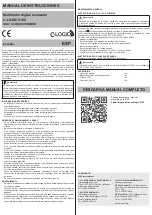DS3112
101 of 133
11.1.4 Capture-DR
11.1.9 Update-DR
11.1.1 Test-Logic-Reset
Upon power-up of the DS3112, the TAP controller will be in the Test-Logic-Reset state. The Instruction
register will contain the IDCODE instruction. All system logic on the DS3112 will operate normally.
11.1.2 Run-Test-Idle
Run-Test-Idle is used between scan operations or during specific tests. The Instruction register and Test
register will remain idle.
11.1.3 Select-DR-Scan
All test registers retain their previous state. With JTMS low, a rising edge of JTCLK moves the controller
into the Capture-DR state and will initiate a scan sequence. JTMS high moves the controller to the Select-
IR-SCAN state.
Data can be parallel-loaded into the Test Data registers selected by the current instruction. If the
instruction does not call for a parallel load or the selected register does not allow parallel loads, the Test
register will remain at its current value. On the rising edge of JTCLK, the controller will go to the Shift-
DR state if JTMS is low or it will go to the Exit1-DR state if JTMS is high.
11.1.5 Shift-DR
The Test Data register selected by the current instruction will be connected between JTDI and JTDO and
will shift data one stage towards its serial output on each rising edge of JTCLK. If a Test register selected
by the current instruction is not placed in the serial path, it will maintain its previous state.
11.1.6 Exit1-DR
While in this state, a rising edge on JTCLK with JTMS high will put the controller in the Update-DR
state, which terminates the scanning process. A rising edge on JTCLK with JTMS low will put the
controller in the Pause-DR state.
11.1.7 Pause-DR
Shifting of the Test registers is halted while in this state. All Test registers selected by the current
instruction will retain their previous state. The controller will remain in this state while JTMS is low. A
rising edge on JTCLK with JTMS high will put the controller in the Exit2-DR state.
11.1.8 Exit2-DR
While in this state, a rising edge on JTCLK with JTMS high will put the controller in the Update-DR
state and terminate the scanning process. A rising edge on JTCLK with JTMS low will enter the Shift-DR
state.
A falling edge on JTCLK while in the Update-DR state will latch the data from the shift register path of
the Test registers into the data output latches. This prevents changes at the parallel output due to changes
in the shift register. A rising edge on JTCLK with JTMS low will put the controller in the Run-Test-Idle
state. With JTMS high, the controller will enter the Select-DR-Scan state.
11.1.10 Select-IR-Scan
All Test registers retain their previous state. The Instruction register will remain unchanged during this
state. With JTMS low, a rising edge on JTCLK moves the controller into the Capture-IR state and will
initiate a scan sequence for the Instruction register. JTMS high during a rising edge on JTCLK puts the
controller back into the Test-Logic-Reset state.


















